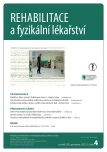Gait rehabilitation in Parkinson’s disease patients – Cueing therapy
Authors:
Dvořáčková D.; Pánek D.
Authors‘ workplace:
Katedra fyzioterapie, Fakulta tělesné výchovy a sportu, Univerzita Karlova, Praha
Published in:
Rehabil. fyz. Lék., 28, 2021, No. 4, pp. 154-157.
Category:
Original Papers
doi:
https://doi.org/10.48095/ccrhfl2021154
Overview
Parkinson’s disease is the second most common neurodegenerative disease, with an increasing trend worldwide. One of the characteristic motor manifestations of the disease are continuous and episodic gait disorders, which affect the lives of up to 89% of all patients with Parkinson’s disease. Freezing is an episodic gait disorder characterised as a sudden cessation of movement and an inability to take an effective step. Cueing therapy is a worldwide known and used therapy for acute freezing, which uses external stimuli to facilitate movement. Although the clinical effect of cueing has been described in a number of studies, its mechanism of action has not been fully elucidated.
Keywords:
Parkinson’s disease – rehabilitation – cueing – freezing
Sources
- Sveinbjornsdottir S. The clinical symptoms of Parkinson’s disease. J Neurochem 2016; 139 (Suppl 1): S318–S324. doi: 10.1111/jnc.13691.
- Wong S, Gilmour H, Ramage-Morin PL. Parkinson’s disease: prevalence, diagnosis and impact. Health Rep 2014; 25(11): 10–14.
- Jagmag SA, Tripathi N, Shukla SD et al. Evaluation of models of Parkinson’s disease. Front Neurosci 2016; 9 : 503. doi: 10.2289/fnins.2015.00503.
- Růžička E, Roth J, Kaňovský P et al. Extrapyramidová onemocnění. Parkinsonova nemoc a parkinsonské syndromy. Praha: Galén 2000. ISBN 80-7262-048-7.
- Franková V, Horská I. Psychiatrické příznaky u Parkinsonovy nemoci ve vyšším věku. Psychiatr Praxi 2018; 19(2): 48–52. doi: 10.36290/psy.2018.012.
- Magdi A, Mohammed Sayed Ahmed A, Elsayed E et al. Effects of cueing techniques on gait, gait-related mobility, and functional activities in patients with Parkinson’s disease: a systematic review and meta-analysis. Physical Therapy Reviews 2021; 26(3): 188–201. doi: 10.1080/10833196.2021.1908728.
- Srp M, Gál O, Konvalinková R et al. Fyzioterapie u Parkinsonovy nemoc v České republice – demografická studie. Česk Slov Neurol N 2018; 81(2): 95–99. doi: 10.14735/amcsnn2018194.
- Gál O, Srp M, Konvalinková R et al. Physiotherapy in Parkinson’s disease: building ParkinsonNet in Czechia. Parkinson’s Disease 2017; 2017: ID8921932 : 1–7. doi: 10.1155/2017/8921932.
- Keus S, Munneke M, Graziano M et al. European physiotherapy guidelines for Parkinson’s disease. The Netherlands: KNGF/Parkinson
- Net 2014.
- Giladi N, Horak F Hausdorff J. Classification of gait disturbances: distinguishing between continuous and episodic changes. Mov Disord 2013; 28(11): 1469–1473. doi: 10.1002/mds.25672.
- Kosutszka Z, Fietzek U, Valkovic P. Clinical trials for gait disorders in Parkinson’s disease. In: Perez-Lloret S (ed.). Clinical trials in Parkinson’s disease. New York: Springer 2021 : 137–161. doi: 10.1007/978-1-0716-0912-5.
- Rahimpour S, Gaztanaga W, Yadav AP et al. Freezing of Gait in Parkinson’s disease: invasive and noninvasive neuromodulation. Neuromodulation 2021; 24(5): 829–843. doi: 10.1111/ner.13347.
- Zhang WS, Gao C, Tan YY et al. Prevalence of freezing of gait in Parkinson’s disease: a systematic review and meta-analysis. J Neurol 2021; 268(11): 4138–4150. doi: 10.1007/s00415-021-10685-5.
- Perez-Lloret S, Nergre-Pages L, Damier P. Prevalence, determinants, and effect on quality of life of Freezing of Gait in Parkinson disease. JAMA Neurol 2014; 71(7): 884–890. doi: 10.1001/jamaneurol.2014.753.
- Brožová H. Freezing – poruchy chůze. Neurol Praxi 2013; 14(4): 179–181.
- Weiss D, Schoellmann A, Fox MD et al. Freezing of gait: understanding the complexity of an enigmatic phenomenon. Brain 2020; 143(1):
- 14–30. doi: 10.1093/brain/awz314.
- Shine J, Maismith SL, Lewis SJG et al. The pathophysiological mechanisms underlying
- freezing of gait in Parkinson’s disease. J Clin Neurosci 2011; 18(9): 1154–1157. doi: 10.1016/j.jocn.2011.02.007.
- Gao C, Liu J, Tan Y et al. Freezing of gait in Parkinson’s disease: pathophysiology, risk factors and treatments. Transl Neurodegener 2020; 9(12): 1–22. doi: 10.1186/s40035-020-
- -00191-5.
- Lim I, van Wegen E, Jones D et al. Does
- cueing training improve physical activity in patients with Parkinson’s disease? Neurorehabil Neural Repair 2010; 24(5): 469–477. doi: 10.1177/1545968309356294.
- Ginis P, Nackaerts E, Nieuwboer A et al. Cueing for people with Parkinson’s disease with freezing of gait: a narrative review of the state-of-art and novel perspectives. Ann Phys Rehabil Med 2018; 61(5): 407–413. doi: 10.1016/j.rehab.2017.08.002.
- Barthel C, Nonnekes J, van Helvert M et al. The laser shoes: a new ambulatory device to alleviate freezing of gait in Parkinson disease. Neurology 2018; 3(1): e167–e174. doi: 10.1212/WNL.0000000000004795.
- Dalla Bella S, Benoit CE, Farrugia N et al. Effects of musically cued gait training in Parkinson’s disease: beyond a motor benefit. Ann N Y Acad Sci 2015; 1337 : 77–85. doi: 10.1111/nyas.12651.
- McCandless P, Evans BJ, Janssen J et al. Effect of three cueing devices for people with Parkinson’s disease with gait initiation difficulties. Gait Posture 2016; 44 : 7–11. doi: 10.1016/j.gaitpost.2015.11.006.
- Sarma SV, Cheng ML, Eden U et al. The effects of cues on neurons in the basal ganglia in Parkinson’s disease. Front Integr Neurosci 2012; 6 : 40. doi: 10.3389/fnint.2012.00040.
- Dvořáčková D, Pánek D, Pavlů D et al. Změny zdrojové aktivity mozku v sLORETA zobrazení při chůzi stimulované zevními zrakovými a sluchovými podněty (cueingem) u pacientů s Parkinsonovou nemocí. Rehabilitácia 2019; 56(4): 306–314.
Labels
Physiotherapist, university degree Rehabilitation Sports medicineArticle was published in
Rehabilitation & Physical Medicine

2021 Issue 4
Most read in this issue
- Gait rehabilitation in Parkinson’s disease patients – Cueing therapy
- Effect of dynamic neuromuscular stabilization in patients after arthroscopy of the shoulder joint
- Influencing the range of motion using trigger point therapy – systematic review
- Update of the Czech translation of the International Classification of Functioning, Disability and Health
